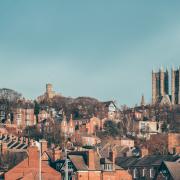Flamborough might be small but it has a big beach bag full of fun stuff for visitors to do

You can’t miss Flamborough. It’s not big or flashy or pulsating with nightlife, but it does have a ruddy great big lighthouse, dominating the headland in all its bright white 87ft-high glory.
The rather beautiful cylindrical brick tower, built in 1806 to replace a still-standing chalk tower built in 1669, was fully automated in early 1996 (the last keepers left on May 8th) and is now monitored and controlled by Trinity House, a charity that supports mariners, from its HQ in Harwich, Essex (that’s a long round-trip just to replace a light bulb, isn’t it?).
It might not be manned anymore, but there are still plenty of people on hand at the lighthouse visitor centre, from where you can book a guided tour of the tower and enjoy incredible views across the North Sea (watch out for seals bobbing about in the water), up the coast towards the seabird sanctuary at Bempton Cliffs and south towards Sewerby Hall Zoo, where you’ll find penguins, capuchin monkeys and raccoon dogs as well as the usual common or coastal garden seagulls.
If you’re planning on heading out to Flamborough Head, the lighthouse is a pretty good place to park up, partly because you can pop into the neighbouring Headlands Restaurant for a plate of Whitby scampi and chips (oh, those chips…) and partly because it presents you with a cobweb-blasting hike along the clifftop in both directions.

Before you set off though, take a minute or two to have a look at the toposcope (an orientation table for notable features in the landscape) that sits alongside the lighthouse to commemorate the Battle of Flamborough Head. The naval battle, which took place on September 23rd 1779, was between a combined Franco-American squadron, led by Continental Navy officer John Paul Jones, and two British escort vessels protecting a large merchant convoy. Thankfully, the only battles happening off the coast now are between bird-watching boats jostling for position during nesting season.
The 400ft-high chalk cliffs spanning north and south from the lighthouse are deeply impressive, offering some of the best sea views in the British Isles, but do be careful if you’re heading to North Landing, South Landing or Selwicks Bay as constant erosion from the sea and the weather means the cliff is creeping inland, leaving crumbling edges that can disappear from under foot.
Don’t let that put you off though – a bit of fleet footwork will reap incredible rewards for bird-watchers, hikers, kayakers, kite-surfers, anglers, rock-poolers, beachcombers and would-be hermits (there are caves to explore if you’re that way inclined, or if your family are just testing you).
What Flamborough lacks in terms of traditional tourist attractions, it more than makes up for in tremendous scenery, wildlife and outdoor pursuits. The sandy beaches at North and South Landing provide the perfect base for a great family day, digging, playing, paddling and eating your own bodyweight in ice cream while watching the colourful cobble boats bob in and out as they take the many tourists for a jaunt along the coast and anglers further out to sea to cast their lines.

And if beach rock-pooling whets your appetite for things that crawl, swim, scuttle and nip, you don’t have to walk far to find one of only a handful of Wildlife Trust marine centres in the UK. The Yorkshire Wildlife Trust Living Seas Centre on South Sea Road is free to enter and offers a host of interactive displays, bird ringing demonstrations, shore searches, guided walks and natural arts and crafts, all focusing on the weird and wonderful wildlife beneath the North Sea waves.
As well as keeping track of the latest sightings of dolphins, seals and whales along the coast (so you know where to lurk with your binoculars), the centre also keeps a close eye on the quarter of a million or so breeding seabirds that flock to Flamborough Head every spring. Although, to be fair, you could probably spot them on your own, what with there being literally thousands of them squawking, swooping and pooping all over the place.
If you still haven’t had your fill of our feathered friends (you’re insatiable), the Living Seas Centre teams up with the fishing cobble owners on North Landing to run Sea Safaris from April to July, offering amazing close up, nose-to-beak views of puffins, kittiwakes and razorbills.
When you’re finally bored of the beach (it could happen), Danes Dyke nature reserve runs inland from the cliffs at Flamborough, offering lots of lovely shaded woodland walks peppered with colour all year round, from snowdrops early in the year through to yellow winter aconites via abundant bunches of bluebells.

If you go down to the woods in autumn, watch out for the astonishing array of fungi on display. Danes Dyke ravine makes the reserve a much wetter place than many of the woods in East and North Yorkshire, making it a moist and welcoming spot for the various marvellous and occasionally mouldy-looking members of the mushroom community. Just don’t be tempted to munch any of them – even if you do happen to have a pack of garlic butter in your back pocket – unless you’re absolutely sure it’s safe. And, even then, don’t.
Save yourself instead for the seafood platter at The Seabirds, the roast lunch at The Ship Inn or the steak pie at the Rose and Crown in Flamborough village. And don’t even think about the calories – you’ll walk a lot of them off hiking back to the lighthouse to pick up the car.



























